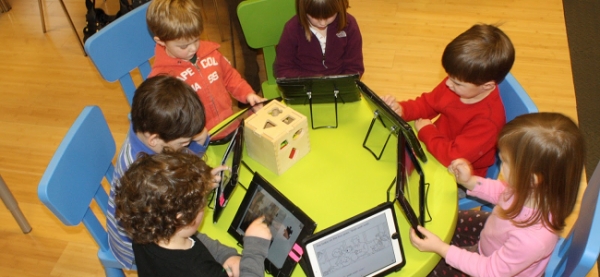"Systems such as IWBs still focus on a single point of interaction for students at the front of the classroom."
Many schools have invested time, money and training into systems like interactive whiteboards, which allow for a richer educational experience. However, these systems still focus on a single point of interaction for students at the front of the classroom. The next stage, and the one that will be coming soon to a class near you, is a step beyond this – a truly connected classroom.
Connected classrooms will not happen at once, and many schools have already begun the process of incrementally introducing the key elements of a connected classroom:
Individual devices like the new Samsung Galaxy Tab 4 Education will now allow schools to purchase – for the first time – reliable, secure and safe personal tablets for pupils that boast features well beyond their price point. With a split-screen display and Near Field Communication (NFC) over Wi-Fi, teachers can use these tablets to drive a new level of interactive learning, weaving individual activities with group engagement.
Display screens will provide a smart alternative to traditional projectors and interactive white boards, enabling students to enjoy a rich multimedia experience that captures and holds their attention, whilst being able to communicate with students’ personal devices via a simple piece of hardware. Teachers will now be able to take individual work being done by students on their personal device and share it with the class; providing new methods of engaging and stimulate pupils.
Networking software will support both these sets of tools, connecting multiple devices together. The new generation of software encourages collaboration in the classroom, enabling students to write directly on their screens, capturing videos and images and allowing the use of a wide range of file formats. Other software allows for easy monitoring of students’ activity, providing opportunities for teachers to help when pupils are struggling or off-task.
Content and applications have undergone a revolution. Many schools have been struggling to catch up and move away from a locally hosted, license-purchasing model of purchasing educational applications. Cloud services have transformed the marketplace, reducing costs and allowing for flexible purchasing arrangements – as the applications themselves become increasingly effective and intuitive.
Background services become increasingly important as school systems become more complex. More mobile devices and users means that wireless upgrades may be required – or new suites of software like Microsoft Office 365 or One Drive.
Printing will remain a key part of educational IT for the time being. Although in an office environment paperless working is achievable, the current reality is that the production of hard copies of material is a requirement for schools. As a result, mobile printing capabilities – allowing students, teachers and other staff to print from their devices, rather than fixed computers will become key.
"We have seen through our own research that introducing new tablets as ‘personal devices’ for pupils promoted collaboration and self-directed learning."
All of the technology above is already available, but classrooms are often not yet reaching their potential. Each of the new technologies listed above come with fantastic benefits of their own, and we have seen through our own research that introducing new tablets as ‘personal devices’ for pupils promoted collaboration and self-directed learning. Pupils were more likely to find their own materials, allowing teachers to focus less on formal instruction.
In education – like many sectors – IT budgets are stretched, and we recognise that a modular approach allows for flexibility with procurement. This allows schools to choose from a range of different technologies to introduce individually or in stages, rather than requiring a complete IT overhaul.
However, I believe that the classroom of the future will only become a reality once teachers and students are comfortable with all these elements working together to provide incredible interactive learning. All of the major technology providers have been working to realise this vision, and we are very excited to see what the next few years will bring. The hardware and software that we are seeing emerge from all of our partners – including Google, Samsung and Apple – shows fantastic potential.
What technology are you excited to bring into your classroom? Let us know in the comments.


















